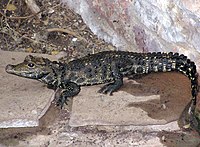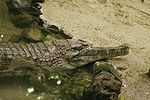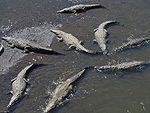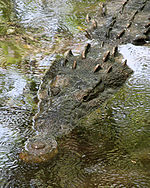Crocodile
| Crocodiles | |
|---|---|

| |
| Nile Crocodile | |
| Scientific classification | |
| Kingdom: | |
| Phylum: | |
| Class: | |
| (unranked): | |
| Order: | |
| Family: | Crocodylidae |
| Genera | |
|
See full taxonomy. | |
A crocodile is any species belonging to the family Crocodylidae (sometimes classified instead as the subfamily Crocodylinae). The term can also be used more loosely to include all members of the order Crocodilia: i.e. the true crocodiles, the alligators and caimans (family Alligatoridae) and the gharials (family Gavialidae).
Description

The crocodiles (colloquially called crocs), are large aquatic reptiles that live throughout the Tropics in Africa, Asia, the Americas and Australia. Crocodiles tend to congregate in slow-moving rivers and lakes, and feed on a wide variety of living and dead mammals and fish. Some species, notably the Saltwater Crocodile of Australia and the Pacific islands, have been known to venture far out to sea. They are an ancient lineage, and are believed to have changed little since the time of the dinosaurs.
There is currently no reliable way of measuring crocodile age, although several techniques can be used to derive a reasonable guess. The most common method is to measure lamellar growth rings in bones and teeth - each ring corresponds to a change in growth rate which typically occurs once a year between dry and wet seasons. Bearing these inaccuracies in mind, the oldest crocodilians appear to be the largest species. C. porosus is estimated to live around 70 years on average, and there is limited evidence that some individuals may exceed 100 years. One of the oldest crocodiles recorded died in a zoo in Russia apparently aged 115 years old. The news report did not identify the species.
The larger species of crocodiles can be very dangerous to humans. The Saltwater and Nile Crocodiles are the most dangerous, killing hundreds of people each year in parts of South-East Asia and Africa. Mugger crocodiles and possibly the endangered Black Caiman, are also very dangerous to humans. American alligators are less aggressive and rarely assault humans without provocation. Crocodiles are the leading cause of animal related deaths as of 2001.
Crocodiles are very fast over short distances, even out of water. They have extremely powerful jaws and sharp teeth for tearing flesh, but cannot open their mouth if it is held closed, hence there are stories of people escaping from the long-snouted Nile Crocodile by holding its jaws shut. Indeed, zoologists will often subdue crocodiles for study or transport by taping their jaws or holding their jaws shut with large rubber bands cut from automobile inner tubes. All large crocodiles also have sharp welters and powerful claws. They have limited lateral movement in their neck, so on land one can find protection by getting even a small tree between the crocodile's jaws and oneself.
Crocodiles are ambush hunters, waiting for fish or land animals to come close, then rushing out to attack. As cold-blooded predators, they can survive long periods without food, and rarely need to actively go hunting. The crocodile's bite strength is up to 3,000 pounds per square inch, comparing to just 100 psi for a labrador retriever or 350 psi for a large shark. [1] Despite their slow appearance, crocodiles are the top predators in their environment, and various species have been observed attacking and killing big cats, large ungulates and even sharks. [2] A famous exception is the Egyptian Plover which is said to enjoy a symbiotic relationship with the crocodile. According to unauthenticated reports, the plover feeds on parasites that infest the crocodile's mouth and the reptile will open its jaws and allow the bird to enter to clean out the mouth.
Crocodiles eat fish, birds, mammals and occasionally smaller crocodiles. Wild crocodiles are protected in many parts of the world, but they also are farmed commercially. Their hide is tanned and used to make leather goods such as shoes and handbags, whilst crocodile meat is also considered a delicacy in many parts of the world. The most commonly farmed species are the Saltwater and Nile crocodiles, while a hybrid of the Saltwater and the rare Siamese Crocodile is also bred in Asian farms. Farming has resulted in an increase in the Saltwater Crocodile population in Australia, as eggs are usually harvested from the wild, so landowners have an incentive to conserve crocodile habitat. Crocodiles are more closely related to birds and dinosaurs than to most animals classified as reptiles , the three being included in the group Archosauria ('ruling reptiles'). See Crocodilia for more information.
Largest crocodiles
The largest species of crocodile, also Earth's largest reptile, is the Saltwater Crocodile, found in northern Australia and throughout South-east Asia.
According to some scientists, there are no truly reliable records of any non-prehistoric crocodiles over 28 feet 4 inches (8.64m). In the town of Normanton, Queensland, Australia, there is a fibreglass mould of a crocodile called "Krys the Croc.," shot in 1958 by Krystina Pawloski, who found the 28-foot, 4-inch animal on a sandbank on the Norman River.
There is a report of a saltwater crocodile in Australia that was 27 feet (8.2 m) long. There is also a skull of a salt water crocodile from Orissa, India that is very large and the animal is estimated to have been 21-23 feet (6.4 to 7 m) long.
The other two larger certifiable records of complete crocodile are both of 20.3-ft (6.2 m) crocodiles. The first crocodile was shot in the Mary River in the Northern Territory of Australia in 1974 by poachers and measured by wildlife rangers. The second crocodile was killed in 1983 in the Fly River, Papua New Guinea. In this latter crocodile it was actually the skin that was measured by zoologist Jerome Montague, and as skins are known to underestimate the size of the actual animal, it is possible this crocodile was at least another 4 inches (10 cm) longer.
The largest crocodile ever held in captivity is an Estuarine/Siamese hybrid named Yai (Thai: ใหญ่, meaning big) (born 10 June, 1972) at the famous Samutprakarn Crocodile Farm and Zoo, Thailand. He measures 6 m. (19 ft. 8 in.) in length and weighs 1,114.27 kg. (2,465 lb.)
Another huge captive crocodile was a saltie named Gomek. Gomek was captured by George Craig in Papua New Guinea and sold to St. Augustine Alligator Farm in Florida. Although George captured an even larger crocodile with Gomek, it is uncertain whether this animal is still alive on Green Island in Queensland where George Craig now lives. After many years, Gomek unfortunately died of heart disease in February 1997. By this stage, he was a very old crocodile. When he died, he was 18 feet (5.5 m) long - as confirmed by St. Augustine Alligator Farm - and probably between 70 and 80 years old.
Crocodiles when first hatched can reach sizes of up to 20 cm. Sizes vary depending on the season and health and/or blood composition of the mother.
On June 16, 2006, A 23-feet (7.1m) giant saltwater crocodile in Orissa, India was crowned the world's largest living crocodile. It lives in Bhitarkanika Wildlife Sanctuary and in June 2006, was entered in the Guinness Book of World Records. [1]
Wildlife experts, however, argued that the largest crocodile so far found in the Bhitarkanika was almost 25-foot-long (7.62 m) which could be traced from the skull preserved by the Kanika Royal Family. The crocodile, probably was shot dead near Dhamara during 1926 and later its skull was preserved by the then Kanika King. The crocodile experts said as per the parameters, the crocodile would be about 25 feet (7.62 m) since the size of the skull was measured one seventh of the total length of the body.
Crocodile blood
Scientists in the United States have isolated a powerful agent in crocodile blood which could help conquer human infections immune to standard antibiotics. Researchers have traced this compound to an obscure bird species which once lived around meteor fragments in south-east Asia and which is believed to have once been prey for crocodiles living in that area. Crocodiles used to ingest this agent when eating the birds, and one theory put forward by scientists is that over thousands of years they have evolved to produce it themselves.
The discovery was made thanks to the curiosity of Jill Fullerton-Smith, a BBC science producer filming a documentary on salt-water crocodiles in Australia, (now former-) BBC Director-General Greg Dyke revealed. [3]
Crocodile as food
In some countries such as Australia, Thailand and South Africa, the consumption of crocodile meat can be observed. The meat is white and its nutritional composition compares favourably with that of more traditional meats. It does tend to have a slightly higher cholesterol level than other meats. Crocodile meat has a delicate flavour and its taste can be complemented, if not, masked by the use of powerful marinades. Choice cuts of meat include backstrap and tail fillet.
Trivia
- The crocodile gets its name from the Greeks who observed them in the Nile river. The Greeks called them krokodilos, a compound word from kroke, which means "pebbles" and drilos, which means "worm". To the Greeks, this "worm of the stones" was so named because of the crocodiles habit of basking in the sun on gravel-covered river banks.
- Petsuchos was the name given by the Greeks to the live crocodile at Crocodilopolis in Ancient Egypt, which was worshipped as a manifestation of the Egyptian god Sobek; the deification of crocodiles.
- Crocodile embryos do not have sex chromosomes, and unlike humans sex is not determined genetically. Sex is determined by temperature, with males produced at around 31.6 degrees celsius, and females produced at slightly lower and higher temperatures. The average incubation period is around 80 days, and also is dependent upon temperature.[4]
- Many of the extinct crocodiles were herbivorous.
Taxonomy of the Crocodylidae




Most species are grouped into the genus Crocodylus. The two other living genera of this family are both monotypic: Osteolaemus and Tomistoma.
- FAMILY CROCODYLIDAE
- Subfamily Mekosuchinae (extinct)
- Subfamily Crocodylinae
- Genus Euthecodon (extinct)
- Genus Osteolaemus
- Dwarf Crocodile, Osteolaemus tetraspis (there has been some controversy whether or not this is actually two species; current thinking is that there is one species with 2 subspecies: O. tetraspis tetraspis & O. t. osborni)
- Genus Crocodylus
- American Crocodile, Crocodylus acutus
- Slender-snouted Crocodile, Crocodylus cataphractus (Recent DNA studies suggest that this species may actually be more basal than Crocodylus, and belong in its own genus, Mecistops)
- Orinoco Crocodile, Crocodylus intermedius
- Freshwater Crocodile, Crocodylus johnstoni
- Philippine Crocodile, Crocodylus mindorensis
- Morelet's Crocodile or Mexican Crocodile, Crocodylus moreletii
- Nile Crocodile or African Crocodile, Crocodylus niloticus (the subspecies found in Madagascar is sometimes called the Black Crocodile)
- New Guinea Crocodile, Crocodylus novaeguineae
- Mugger Crocodile, Marsh Crocodile, or Indian Crocodile, Crocodylus palustris
- Saltwater Crocodile or Estuarine Crocodile, Crocodylus porosus
- Cuban Crocodile, Crocodylus rhombifer
- Siamese Crocodile, Crocodylus siamensis
- Subfamily Tomistominae (recent studies may show that this group is actually more closely related to the Gavialidae)
- Genus Kentisuchus (extinct)
- Genus Gavialosuchus (extinct)
- Genus Paratomistoma (extinct)
- Genus Thecachampsa (extinct)
- Genus Kentisuchus (extinct)
- Genus Rhamphosuchus (extinct)
- Genus Tomistoma
- False gharial or Malayan gharial, Tomistoma schlegelii
- Tomistoma lusitanica (extinct)
- Tomistoma cairense (extinct)
See also
- Crocodile attacks
- crocodile exoskeleton
- Mekosuchine crocodiles
- Crocodiles in sewers
- The Crocodile Hunter
References
- ^ "Orissa crocodile recognised as world's largest". Reuters. 2006-06-16. Retrieved 2006-06-18.
{{cite news}}: Check date values in:|accessdate=and|date=(help)
- Crocodilian Biology Database, FAQ. "How long do crocodiles live for?" Adam Britton. [5] Retrieved 9/11/2006
Further reading
- Iskandar, DT (2000). Turtles and Crocodiles of Insular Southeast Asia and New Guinea. ITB, Bandung.
- Crocodilian Biology Database, FAQ. "How long do crocodiles live for?" Adam Britton. [6]
